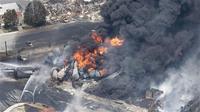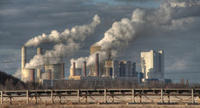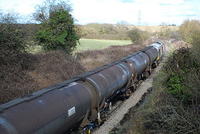-
Debate continues over releasing Pennsylvania crude oil shipment information
Shipment of crude oil by rail in the United States has increased from 800,000 barrels a day in 2012 to 1.4 million in 2014. In western Pennsylvania, over seventy-five million gallons of crude oil are passing through Allegheny and Westmoreland counties to refineries in Philadelphia. Release of the recently classified rail transport records by Pennsylvania Emergency Management Agency (PEMA) was a result of a federal mandate ordering railway companies to share information on interstate shipments of crude oil with state emergency management officials.Railway companies claim that releasing the information threatens security and is commercially sensitive.
-
-
Reliance on BP, feeble regulations make U.S. partially culpable in Deepwater Horizon oil spill
A recent ruling by a federal judge that BP was “grossly negligent” in the 2010 Deepwater Horizon oil rig spill in the Gulf of Mexico placed the majority of blame on the multinational oil and gas company. Although not on trial in this case, the federal government was also culpable in the largest oil spill in U.S. history, according to a new paper. Based on reports from the National Commission on the BP Deepwater Horizon Oil Spill and Offshore Drilling, the Chief Council’s Report and other government documents, the report’s authors determined that the government’s reliance on market-based accountability mechanisms and its failure to implement a regulatory process based on a mutually agreed upon set of robust standards and voluntary information disclosure led to the largest oil spill in U.S. history.
-
-
Smart grid needed to shift electrical system to alternative energy: Expert
Solar, wind, and other alternative sources are easier on the environment but less predictable than coal, gas, or oil-fired plants, demanding a more sophisticated distribution and delivery system. A more resilient, responsive electrical grid – a smart grid – would adjust electrical loads to energy demands, preventing the shutdowns that leave people without air conditioning just when they need it most. A smart grid is thus a flexible grid – it is an infrastructure which allows shifting load and demand around effectively, ultimately balancing the electrical power and delivery system at lower costs.
-
-
Fusion reactor concept could be cheaper than coal
Fusion energy almost sounds too good to be true — zero greenhouse gas emissions, no long-lived radioactive waste, a nearly unlimited fuel supply. Perhaps the biggest roadblock to adopting fusion energy is that the economics have not penciled out. Fusion power designs aren’t cheap enough to outperform systems that use fossil fuels such as coal and natural gas. University of Washington engineers hope to change that. They have designed a concept for a fusion reactor that, when scaled up to the size of a large electrical power plant, would rival costs for a new coal-fired plant with similar electrical output.
-
-
Petroleum industry, railroads want deadline extension for phasing out old tank cars

Transportation of crude oil by train jumped to 408,000 in 2013, from 11,000 in 2009, partly due to the rise in production from North Dakota’s Bakken region, where oil production has surpassed pipeline capacity. The increasing use of rail to transport crude oil has resulted in several accidents. The Department of Transportation want to phase out older tank cars — because they have thinner shells and are thus more vulnerable to accidents when transporting flammable liquids like crude oil – and replace them with new, safer tank cars with thicker shells. The petroleum industry and U.S. railroads want DOT to extend the deadline for phasing out old tankers from two years to four years.
-
-
Research powerhouses team up to develop climate models for energy applications
Eight national laboratories, four academic institutions, and one private-sector company are partnering in the Climate Modeling for Energy, or ACME, project, designed to accelerate the development and application of fully coupled, state-of-the-science Earth system models for scientific and energy applications. The project will focus initially on three climate-change science drivers and corresponding questions to be answered during the project’s initial phase.
-
-
New approach can change climate negotiations
Researchers argue that the most important recent innovation in the discussion over how to slow down global warming is the adoption of a “cumulative emissions” approach to emissions of carbon dioxide. The researchers say that though, in the short term, this promises to challenge negotiators trying to achieve a meaningful international climate change agreement, in the longer term it ought to help them focus on the things that matter most. The virtue of using the cumulative emissions approach is clarity: By finding a simpler way to express the overall scale of the problem, the approach – and the IPCC and Calderón reports — give governments and other players less room to pretend that opportunistic or short-term tweaks to emissions paths are sufficient to meet the goals they have set themselves.
-
-
Increased use of natural gas will have little effect on CO2 emissions: Study

Abundant supplies of natural gas will do little to reduce harmful U.S. emissions causing climate change, according to researchers. They found that inexpensive gas boosts electricity consumption and hinders expansion of cleaner energy sources, such as wind and solar.
-
-
To stay below 2°C warming, coal’s rapid phase out is essential, but not enough

A rapid phase out of coal as an electricity source by 2050 would reduce warming by half a degree, according to a new study. The study authors ran a number of scenarios around phasing out fossil fuel emissions from the electricity sector, which produces around 40 percent of global C02 emissions. The electricity sector needs to be decarbonized faster than other sectors, but instead is heading in the opposite direction, increasing carbon intensity and significantly driven by increased coal use, and making it one of the largest sources of recent carbon emission increases.
-
-
West Virginia mulls releasing crude oil shipment information to the public

In May 2014, the U.S. Department of Transportation(DOT) ordered railroads operating trains carrying more than one million gallons of Bakken crude oil to notify state emergency officials in states through which oil-carrying trains travel of the expected movement of such trains. The order came to allow first responders to be better prepared should an accident occur. CSX Corporation agreed to share shipping information with West Virginia officials, but refused to release the information to the public citing concerns about terrorism. DOT made it clear that citing terrorism concerns does not exempt crude oil shipment information from being released to the public.
-
-
People living near “fracking” sites report more health symptoms
Little is known about the environmental and public health impact of certain natural gas extraction techniques — including hydraulic fracturing, also known as “fracking” — that occur near residential areas. A Yale-led study has found a greater prevalence of health symptoms reported among residents living close to natural gas wells, including those drilled by hydraulic fracturing.
-
-
Better solutions for recycle fracking water
Scientists have performed a detailed analysis of water produced by hydraulic fracturing (aka fracking) of three gas reservoirs and suggested environmentally friendly remedies are needed to treat and reuse it. More advanced recycling rather than disposal of “produced” water pumped back out of wells could calm fears of accidental spillage and save millions of gallons of fresh water a year.
-
-
Existing power plants will emit 300 billion more tons of carbon dioxide during use
Existing power plants around the world will pump out more than 300 billion tons of carbon dioxide over their expected lifetimes, significantly adding to atmospheric levels of the climate-warming gas, according to a new study. The study is the first to quantify how quickly these “committed” emissions are growing — by about 4 percent per year — as more fossil fuel-burning power plants are built. Assuming these stations will operate for forty years, the power plants constructed globally in 2012 alone will produce about nineteen billion tons of CO2 during their existence, the researchers project.
-
-
Cutting carbon emissions more than pays for itself with savings on health care spending
Just how large are the health benefits of cleaner air in comparison to the costs of reducing carbon emissions? MIT researchers looked at three policies achieving the same reductions in the United States, and found that the savings on health care spending and other costs related to illness can be big — in some cases, more than ten times the cost of policy implementation. The concluded that savings from healthier air can make up for some or all of the cost of carbon-reduction policies.
-
-
Testing the shelf-life of nuclear reactors’ components
The structural components of advanced reactors such as the sodium fast reactor and the traveling wave nuclear reactor must be able to withstand the extreme levels of radioactivity from the fission reaction itself at temperatures well above 400 Celsius. Unfortunately, standard tests of such components are expensive, require increasingly rare test reactors and test periods that are impractical. Researchers have devised a quick way to test the structural materials used to build nuclear reactors by using high-energy beams of charged particles (ions).
-
More headlines
The long view
Trump Is Fast-Tracking New Coal Mines — Even When They Don’t Make Economic Sense
In Appalachian Tennessee, mines shut down and couldn’t pay their debts. Now a new one is opening under the guise of an “energy emergency.”
Smaller Nuclear Reactors Spark Renewed Interest in a Once-Shunned Energy Source
In the past two years, half the states have taken action to promote nuclear power, from creating nuclear task forces to integrating nuclear into long-term energy plans.
